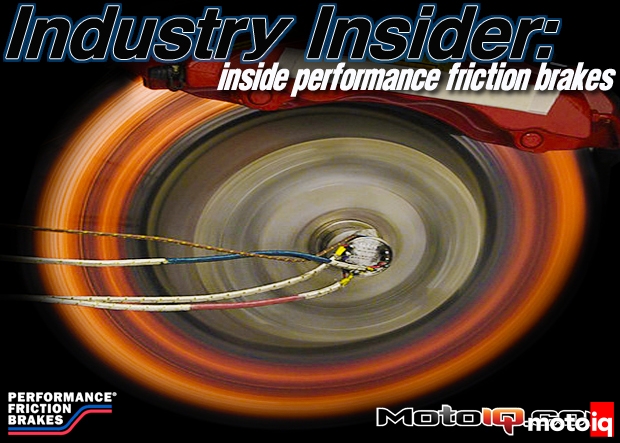,
In the compounding room where batches of friction material are mixed up we could spot several different grades of carbon. Carbon is a versatile friction material. It has a lot of heat resistance and its coefficient of friction is consistent across a wide temperature range. It can be soft and lubricious or harder and more abrasive depending on its grade. We also noted several different metallic powders which appeared to be irons of different grades, with different properties and effective heat ranges. Also present were what appeared to be ceramic powders. Ceramics can have a wide range of abrasive properties and are also quite heat resistant. Other powders seem to be phenolic resins which are thermosetting plastics used as binders to hold the metallic elements together during the manufacturing process.
 |
| When asked what goes in their brake pads, Performance friction was pretty tight lipped. They did show us these vials though. We observed that several types of carbon powder, iron powder, steel fibers, binders and ceramic powders were in these vials. Unfortunately we were not allowed to take pictures of the brake pad manufacturing process. The multi layer method of pad build up is critical for pad performance and secret. |
Performance Friction was more open about what doesn’t go into their pads, the pads do not use any toxic heavy metals or other fibers which have been commonly used in pad material in the past, these are materials such as asbestos, lead, antimony, cadmium, chromium and potassium titanate.
In the compounding room, the various friction materials are weighed out and blended together by a computer controlled compounding process. The batch recipe is brought up by computer and the amount of each element of the compound is controlled by weight, which is monitored in real time, any mistakes and the computer will catch it in process. After blending the compound is tested by the quality department before the batch is released for production.
In the meanwhile laser cut and zinc phosphate treated steel backing plates are powdercoated with Performance Friction’s proprietary process which helps ensure proper bonding of the friction material and resists corrosion. The powdercoating is part of Performance Friction’s Multi-Layer Technology which helps promote long wear, consistent performance and low noise.
 |
| Brian Locke’s Cobb Tuning GTR uses Performance Friction rotors and pads. That the otherwise stock brake system can stop the heavy and powerful GTR is pretty impressive. |
Next the powdercoated backing plates are covered on one side with a secret and specially formulated adhesive mixed with steel fibers. The steel fibers help give a superior mechnical bond from the friction material to the backing plate and provide a damping layer to reduce noise without being compressible which can negatively affect pedal feel. Performance Friction personnel were reluctant to talk about details of this and a lot of what we are talking about is engineering observations of a quick walk though of these secret areas within the plant.
Next the friction material is sintered to the pad. This uses special molds where a precisely measured amount of blended friction material powder is placed in mold over the backing plates, sort of like cupcakes. Then a heated element compresses the friction material with lots of pressure and heat, cooking the material all together. Pads are periodically checked to make sure that this process is working properly as the pads have to be as uncompressible as possible. Compressible pads make for a soft pedal and inconsistent feel and Performance Friction goes through pains to make sure that the pads are not compressible.
 |
| Performance Friction GTR rotors are a lot more crack resistant, cooler running and longer lasting than the stock Nissan parts. They are also cheaper! |
After sintering, the pads are then sent into special ovens to be cured. In curing most of the volatile elements of the binders are vaporized out. This is critical to avoid green fade, the point where uncured binder elements can boil out of a new pad’s surface, acting like a lubricant and reducing the brake’s effectiveness. Not only can the brakes be rendered ineffective if this happens but rotors and the pads surface can become glazed reducing service life and effectiveness even after the pads are bedded in. The pads are stacked into the oven in a carefully prescribed pattern and the temperature is monitored carefully in several points in the oven to ensure all pads are properly cured. Curing is a process where many aftermarket pad manufacturers fall short, hence the reason for a lot of inconsistency from batch to batch of pads. Curing is also why Performance Friction pads do not need an elaborate bedding process before they are ready to be raced on. After curing the pads are ready to be boxed and go.


